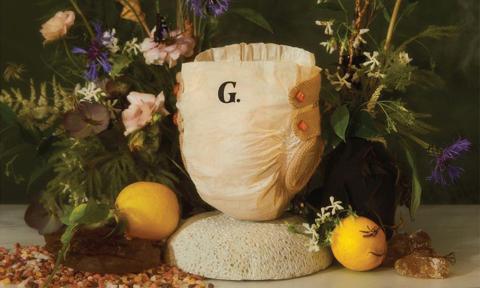
Viewing Goop products and campaigns with a fair dose of skepticism is fair. Gwyneth Paltrow’s lifestyle brand, and the term ‘lifestyle’ is used here very generously, has been responsible for products like the infamous ‘This Smells Like My Vagina’ candle and the $2000 Ouija Board. So when the brand announced that they would be selling diapers now, the world didn’t know whether to think it was a joke or take it in their stride as something Goop would do.
The Diapér, as it was called, would be lined with virgin alpaca wool, encrusted with amber gemstones (for the baby’s emotional cleansing, of course) and infused with scents of bergamot and jasmine. The post also stated that it would be retailed at a price of $120 for 12 Diapérs.
Turns out, the Diapér wasn’t a real thing after all and was just a stunt, in collaboration with the non-profit organisation Baby2Baby, to bring attention to the increasing unaffordability of diapers in the United States of America currently.
Paltrow revealed that she never had to worry about the costs of diapers but was made aware of the diaper tax, which is taxed at the same rate as luxury goods in 33 states of the US. This means it’s not classified as an essential item and is not easily available to a large majority of the population.
While Paltrow’s efforts, and self-awareness, are commendable, why should you also worry about diapers being taxed at a high rate?
The diaper market in India was valued at $1.06 billion in 2020 and was projected to rise another 14% between 2021 and 2026.
Currently the SGST (state tax) on baby diapers is 6%, while the CGST (central tax) is 12%. Currently, a 36 piece pack of diapers can cost between INR 400 to 800, depending on the size and kind of diaper. As compared to the state of affairs in the US, it’s still not at the rate of luxury goods but considering factors like the rapid growth of the market size and a lack of raw materials available for production, the accessibility to diapers might become an issue closer to home as well, considering the growing popularity of disposable diapers vs cloth diapers.
Disposable diapers vs Cloth diapers
The debate is prevalent across the world, with young parents opting for organic, reusable diapers for their children as opposed to disposable options, much to their parents’ and grandparents’ disappointment. In India, disposable diapers are the go-to option for young parents who are not living with joint families as both parents are usually working. Ultimately it comes down to accessibility and affordability. Cotton cloth diapers are great if you’re living in a region with low humidity, as they can take a lot of time to dry and babies go through a LOT of diaper changes throughout the day.
Disposable diapers are a convenient and time-saving option. While a lot of parents think that disposable diapers can cause harm to their babies because of the chemicals used in their production, no major study has corroborated this theory.
As far as their impact on the environment goes, both are equally harmful and non-sustainable. A disposable diaper is not biodegradable and ultimately harmful for the environment. But reusable cotton diapers are equally, if not more, harmful to the environment. Chemicals and pesticides are used in the production of cloth diapers as well, which can seep into the groundwater and cause severe harm to the ecosystem of the region. We also need to consider the extensive amount of labour, water, and land that is used for the production of cotton and the further production costs of converting the usable cotton into cloth diapers. It ultimately comes down to preference and circumstances.
So if you’re a new parent or parent-to-be, make sure you’re aware of the impact a slight tax increase can have on your budget and lifestyle choices.
- Quick links
- Gwyneth Paltrow
- Goop
- childcare


